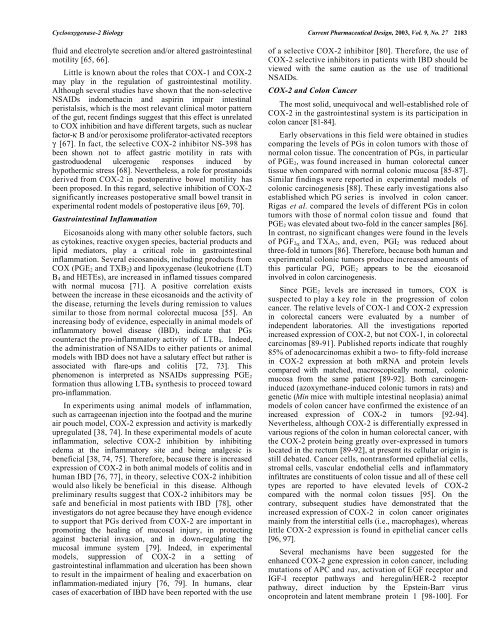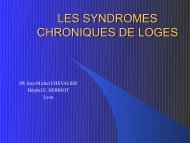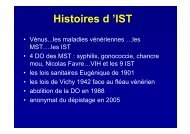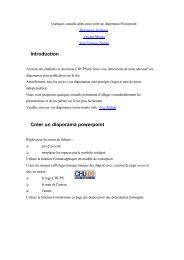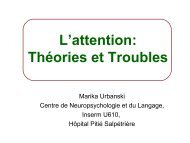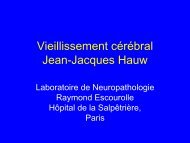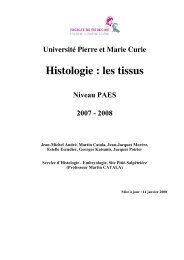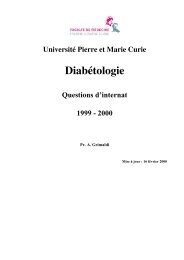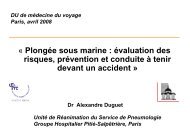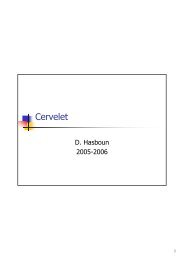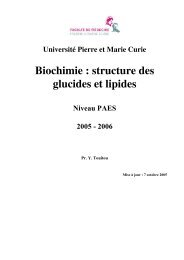Cyclooxygenase-2 Biology
Cyclooxygenase-2 Biology
Cyclooxygenase-2 Biology
Create successful ePaper yourself
Turn your PDF publications into a flip-book with our unique Google optimized e-Paper software.
<strong>Cyclooxygenase</strong>-2 <strong>Biology</strong> Current Pharmaceutical Design, 2003, Vol. 9, No. 27 2183<br />
fluid and electrolyte secretion and/or altered gastrointestinal<br />
motility [65, 66].<br />
Little is known about the roles that COX-1 and COX-2<br />
may play in the regulation of gastrointestinal motility.<br />
Although several studies have shown that the non-selective<br />
NSAIDs indomethacin and aspirin impair intestinal<br />
peristalsis, which is the most relevant clinical motor pattern<br />
of the gut, recent findings suggest that this effect is unrelated<br />
to COX inhibition and have different targets, such as nuclear<br />
factor-κ B and/or peroxisome proliferator-activated receptors<br />
γ [67]. In fact, the selective COX-2 inhibitor NS-398 has<br />
been shown not to affect gastric motility in rats with<br />
gastroduodenal ulcerogenic responses induced by<br />
hypothermic stress [68]. Nevertheless, a role for prostanoids<br />
derived from COX-2 in postoperative bowel motility has<br />
been proposed. In this regard, selective inhibition of COX-2<br />
significantly increases postoperative small bowel transit in<br />
experimental rodent models of postoperative ileus [69, 70].<br />
Gastrointestinal Inflammation<br />
Eicosanoids along with many other soluble factors, such<br />
as cytokines, reactive oxygen species, bacterial products and<br />
lipid mediators, play a critical role in gastrointestinal<br />
inflammation. Several eicosanoids, including products from<br />
COX (PGE2 and TXB2) and lipoxygenase (leukotriene (LT)<br />
B4 and HETEs), are increased in inflamed tissues compared<br />
with normal mucosa [71]. A positive correlation exists<br />
between the increase in these eicosanoids and the activity of<br />
the disease, returning the levels during remission to values<br />
similar to those from normal colorectal mucosa [55]. An<br />
increasing body of evidence, especially in animal models of<br />
inflammatory bowel disease (IBD), indicate that PGs<br />
counteract the pro-inflammatory activity of LTB4. Indeed,<br />
the administration of NSAIDs to either patients or animal<br />
models with IBD does not have a salutary effect but rather is<br />
associated with flare-ups and colitis [72, 73]. This<br />
phenomenon is interpreted as NSAIDs suppressing PGE2<br />
formation thus allowing LTB4 synthesis to proceed toward<br />
pro-inflammation.<br />
In experiments using animal models of inflammation,<br />
such as carrageenan injection into the footpad and the murine<br />
air pouch model, COX-2 expression and activity is markedly<br />
upregulated [38, 74]. In these experimental models of acute<br />
inflammation, selective COX-2 inhibition by inhibiting<br />
edema at the inflammatory site and being analgesic is<br />
beneficial [38, 74, 75]. Therefore, because there is increased<br />
expression of COX-2 in both animal models of colitis and in<br />
human IBD [76, 77], in theory, selective COX-2 inhibition<br />
would also likely be beneficial in this disease. Although<br />
preliminary results suggest that COX-2 inhibitors may be<br />
safe and beneficial in most patients with IBD [78], other<br />
investigators do not agree because they have enough evidence<br />
to support that PGs derived from COX-2 are important in<br />
promoting the healing of mucosal injury, in protecting<br />
against bacterial invasion, and in down-regulating the<br />
mucosal immune system [79]. Indeed, in experimental<br />
models, suppression of COX-2 in a setting of<br />
gastrointestinal inflammation and ulceration has been shown<br />
to result in the impairment of healing and exacerbation on<br />
inflammation-mediated injury [76, 79]. In humans, clear<br />
cases of exacerbation of IBD have been reported with the use<br />
of a selective COX-2 inhibitor [80]. Therefore, the use of<br />
COX-2 selective inhibitors in patients with IBD should be<br />
viewed with the same caution as the use of traditional<br />
NSAIDs.<br />
COX-2 and Colon Cancer<br />
The most solid, unequivocal and well-established role of<br />
COX-2 in the gastrointestinal system is its participation in<br />
colon cancer [81-84].<br />
Early observations in this field were obtained in studies<br />
comparing the levels of PGs in colon tumors with those of<br />
normal colon tissue. The concentration of PGs, in particular<br />
of PGE2, was found increased in human colorectal cancer<br />
tissue when compared with normal colonic mucosa [85-87].<br />
Similar findings were reported in experimental models of<br />
colonic carcinogenesis [88]. These early investigations also<br />
established which PG series is involved in colon cancer.<br />
Rigas et al. compared the levels of different PGs in colon<br />
tumors with those of normal colon tissue and found that<br />
PGE2 was elevated about two-fold in the cancer samples [86].<br />
In contrast, no significant changes were found in the levels<br />
of PGF2α and TXA2, and, even, PGI2 was reduced about<br />
three-fold in tumors [86]. Therefore, because both human and<br />
experimental colonic tumors produce increased amounts of<br />
this particular PG, PGE2 appears to be the eicosanoid<br />
involved in colon carcinogenesis.<br />
Since PGE2 levels are increased in tumors, COX is<br />
suspected to play a key role in the progression of colon<br />
cancer. The relative levels of COX-1 and COX-2 expression<br />
in colorectal cancers were evaluated by a number of<br />
independent laboratories. All the investigations reported<br />
increased expression of COX-2, but not COX-1, in colorectal<br />
carcinomas [89-91]. Published reports indicate that roughly<br />
85% of adenocarcinomas exhibit a two- to fifty-fold increase<br />
in COX-2 expression at both mRNA and protein levels<br />
compared with matched, macroscopically normal, colonic<br />
mucosa from the same patient [89-92]. Both carcinogeninduced<br />
(azoxymethane-induced colonic tumors in rats) and<br />
genetic (Min mice with multiple intestinal neoplasia) animal<br />
models of colon cancer have confirmed the existence of an<br />
increased expression of COX-2 in tumors [92-94].<br />
Nevertheless, although COX-2 is differentially expressed in<br />
various regions of the colon in human colorectal cancer, with<br />
the COX-2 protein being greatly over-expressed in tumors<br />
located in the rectum [89-92], at present its cellular origin is<br />
still debated. Cancer cells, nontransformed epithelial cells,<br />
stromal cells, vascular endothelial cells and inflammatory<br />
infiltrates are constituents of colon tissue and all of these cell<br />
types are reported to have elevated levels of COX-2<br />
compared with the normal colon tissues [95]. On the<br />
contrary, subsequent studies have demonstrated that the<br />
increased expression of COX-2 in colon cancer originates<br />
mainly from the interstitial cells (i.e., macrophages), whereas<br />
little COX-2 expression is found in epithelial cancer cells<br />
[96, 97].<br />
Several mechanisms have been suggested for the<br />
enhanced COX-2 gene expression in colon cancer, including<br />
mutations of APC and ras, activation of EGF receptor and<br />
IGF-I receptor pathways and heregulin/HER-2 receptor<br />
pathway, direct induction by the Epstein-Barr virus<br />
oncoprotein and latent membrane protein 1 [98-100]. For


